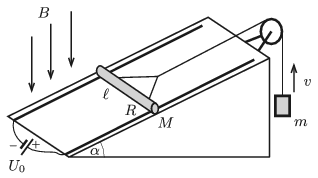 Problem P. 5118. (March 2019)
Problem P. 5118. (March 2019)
P. 5118. A pair of parallel rails of negligible resistance is fixed to a slope of angle of elevation of \(\displaystyle \alpha=30^\circ\), at a distance of \(\displaystyle \ell=10\) cm from each other. A power supply of constant voltage of \(\displaystyle U_0\) is connected across the lower ends of the rails. A horizontal metal rod of mass \(\displaystyle M=30\) g and of resistance \(\displaystyle R=0.2~\Omega\) is placed perpendicularly to the rails. The rod can move frictionlessly. A piece of thread, which is parallel to the rails, is attached to the middle of the rod, and looped over a massless pulley. An object of mass \(\displaystyle m=50\) g is hung to the vertical end of the thread. The arrangement is in vertically upward uniform magnetic field of induction \(\displaystyle B=0.5\) T.

What should the voltage of the power supply be in order that the object of mass \(\displaystyle m\) moves
\(\displaystyle a)\) vertically upward,
\(\displaystyle b)\) vertically downward at a constant speed of \(\displaystyle v=10\) m/s?
(5 pont)
Deadline expired on April 10, 2019.
Sorry, the solution is available only in Hungarian. Google translation
Megoldás. \(\displaystyle a)\) A rúd a lejtőn lefelé mozog \(\displaystyle v\) sebességgel, benne
\(\displaystyle U_\text{ind}=B\ell v\cos\alpha\)
feszültség indukálódik, ami a fémrúdban a külső áramforrással ellenkező irányban, tehát ,,balra'' irányuló,
\(\displaystyle I=\frac{U_0-U_\text{ind}}{R}=\frac{U_0-B\ell v\cos\alpha}{R}\)
nagyságú áramot hoz létre. Az áramjárta vezető rúdra a mágneses mező lejtőre merőleges \(\displaystyle B\cos\alpha\) nagyságú komponense a lejtő esésvonalával párhuzamos, ,,lefelé'' irányuló, \(\displaystyle F=BI\ell\cos\alpha\) nagyságú erőt fejt ki. A csigán átvetett fonalat \(\displaystyle mg\) nagyságú erő feszíti (hiszen az \(\displaystyle m\) tömegű test egyenletesen mozog), a rúd súlyának lejtő irányú komponense pedig \(\displaystyle Mg\sin\alpha\).
Az egyenletesen mozgó rúd mozgásegyenlete:
\(\displaystyle \frac{U_0-B\ell v\cos\alpha}{R}B\ell\cos\alpha+Mg\sin\alpha=mg,\)
ahonnan a keresett feszültség:
\(\displaystyle U_0=\frac{(m-M\sin\alpha)gR+vB^2\ell^2\cos^2\alpha}{B\ell\cos\alpha}=2{,}0~\rm V.\)
\(\displaystyle b)\) Ha az \(\displaystyle m\) tömegű nehezék lefelé mozog állandó \(\displaystyle v\) sebességgel, akkor a fenti végképletben \(\displaystyle v\) helyett \(\displaystyle -v\)-t kell írnunk, és a szükséges feszültség:
\(\displaystyle U_0=\frac{(m-M\sin\alpha)gR-vB^2\ell^2\cos^2\alpha}{B\ell\cos\alpha}=1{,}2~\rm V.\)
Statistics:
40 students sent a solution. 5 points: Bokor Endre, Bukor Benedek, Czett Mátyás, Fiam Regina, Fülöp Sámuel Sihombing, Kalmár Dóra, Lipták Gergő, Máth Benedek, Molnár Mátyás, Morvai Orsolya, Sal Dávid, Telek Dániel, Tiefenbeck Flórián, Vass Bence. 4 points: Andorfi István, Békési Ábel, Bonifert Balázs, Debreczeni Tibor, Endrész Balázs, Hamar Dávid, Mácsai Dániel, Makovsky Mihály, Marozsák Tádé, Merkl Gergely, Olosz Adél, Szabó 314 László. 3 points: 10 students. 2 points: 2 students. 1 point: 2 students.
Problems in Physics of KöMaL, March 2019
